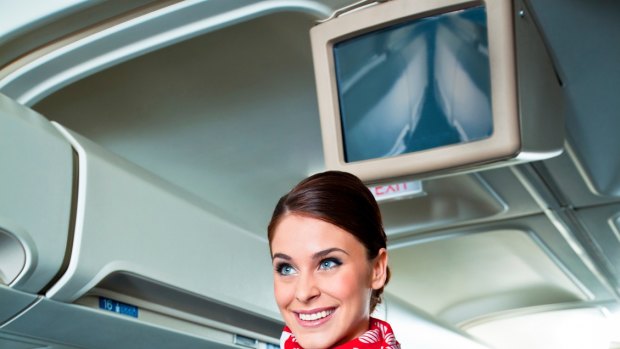This was published 7 years ago
Why flight attendants show you how to use a seatbelt
By George Hobica

Beautiful flight attendant standing in an airplane and demonstrating a seat belts before taking off.Credit: Izabela Habur
If you fly on a commercial airliner and listen to the safety demo (most people don't listen, of course), you may wonder why the video or crew instructs you how to use the seatbelt. The instructions have been the butt of many a comedian's joke ("In case you haven't been in a car since 1965," as Jerry Seinfeld quips in one of his stand-up routines.
But that's precisely the problem. You have been in a car lately; in fact, you probably unbuckled a car seatbelt an hour before boarding your plane, and may have done so dozens of times in the days before your flight.
But car seatbelts work differently from the "lift the buckle" way that airplane seatbelts release. And believe it or not, in a panicked emergency, passengers who might not be thinking clearly because they're disoriented or mentally incapacitated — barely awake before a 6 a.m. takeoff, jetlagged after a long flight, or under the influence of Ambien or alcohol — have been known to reach to the right or left near their thighs, as you would in an automobile, trying to push a seatbelt release button rather reaching for their laps and lifting a flap. In other words, previously established "muscle memory" works against you in a crisis.
How do I know this? Not only have flight attendants told me it happens, but I, someone who travels thousands of miles a year, have done the exact same thing at the end of a 12-hour flight with little sleep as I attempt to release the seatbelt.
Because every second counts when evacuating a plane, any confusion could cost lives. In fact pilots are known to practice muscle memory in the cockpit, touching levers and fingering buttons before takeoff, so that in an emergency they will remember where the controls are located and be able to act quicker.
Something to think about the next time your nose is buried in a newspaper during the safety demo.
TNS
See also: Phone off, tray table up: the reasons behind the rules of air travel
See also: From handcuffs to cockpit cams: 10 secrets things on planes you never knew about
Sign up for the Traveller newsletter
The latest travel news, tips and inspiration delivered to your inbox. Sign up now.